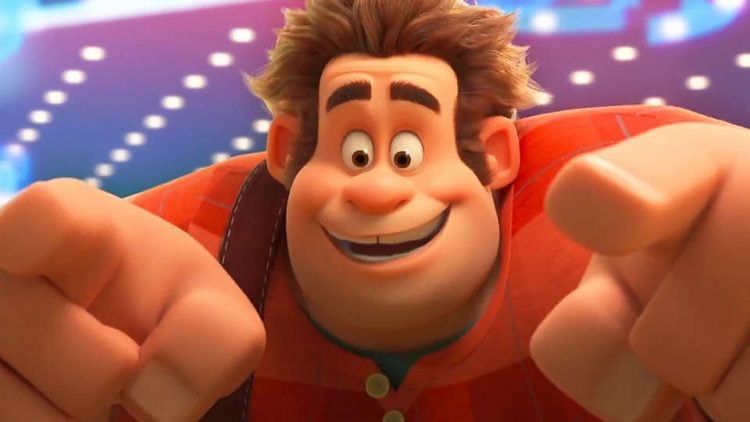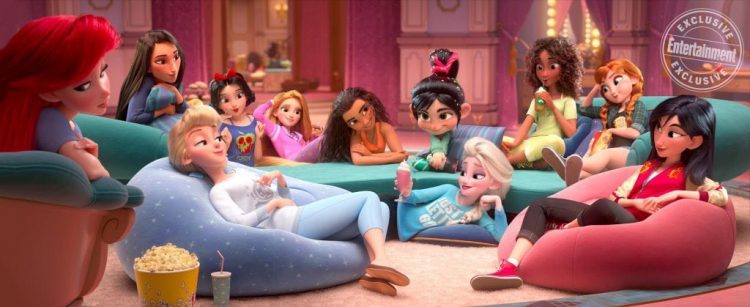
This Internet thing we all use seems pretty durable but is apparently a pretty fragile thing, susceptible to viruses and all sorts of problems. At least, that’s true in the strange but visually lush world of Ralph Breaks the Internet. Ralph (voiced by John C. Reilly) is a lovable lunk of a guy, the antagonist from an old-school video game who we first met in the 2012 animated Wreck-It Ralph.
This newer installment opens with Ralph and Vanellope (voice of Sarah Silverman) as best friends. Ralph is content with the monotony of their daily life in the video arcade: going through the motions in their respective arcade games, then after hours hanging out with other retro video game characters either in the electrical power strip (a sort of Penn Station for the video game set) or swigging root beers at Tapper’s. Vanellope, however, is bored, bored, bored and wants to find new adventures.
When the steering wheel for Vanellope’s game Sugar Rush breaks, the arcade owner plans on retiring the game: There’s only one replacement steering wheel available for this old game and it’s hundreds of dollars on eBay. Rather than have her game vanish and, presumably, Vanellope vanish, Ralph decides he’s going to head off into the great unknown of The Internet, find eBay, buy the steering wheel and have it shipped to the arcade directly. Our hero!
Of course, 80s video game characters heading into the modern Internet is an obvious mismatch and their travels and adventures definitely prove amusing. Where things get much better, however, is when they encounter the tough racer gal Shank (voice of Gal Gadot). She’s like a grown-up, big sister version of Vanellope: they’re both car racers, but Shank’s game is Slaughter Race where she’s driving through a scary urban landscape in a souped up racecar. Vanellope drives a candy car and Sugar Rush, well, it’s definitely not that sort of a game.
To win the steering wheel auction on eBay, Ralph and Vanellope need to earn money and the only way they can do so quickly is by creating viral videos that get millions of likes on a YouTube clone. Helping them achieve that goal is the lithe Yesss (voice of Taraji P. Henson), head of the video network.
To be honest, there’s not really that much of a story here, but I really enjoyed Ralph Breaks the Internet anyway, because of the extraordinary imaginations of the writers and animators. For example, at one point Vanellope heads into the Oh My Disney zone and suddenly there are muppets, Iron Man, Stormtroopers, R2D2 and a lot of princesses fulfilling children’s dreams. Cloying. But then Vanellope finds herself backstage with the princesses in an utterly hilarious scene. The raw cynicism towards “classic” Disney stories alone is worth the cost of the movie ticket. A superb scene, no question.

Where the film has a surprising misstep, however, is when Ralph unleashes a virus on the Internet (hence the title). The virus starts by duplicating Ralph so that there are waves of Ralphs pouring through windows, down roads, over cars, etc. That was a troubling image, but when the clone-Ralphs pile on top of each other to create a monsterous super-Ralph, it’s darn creepy. Because you can still see each individual Ralph, the effect is akin to a maggot-infested piece of meat. Definitely not what Disney Animation was aiming for with the image. Fortunately, this is just a few minutes in an otherwise delightful film, but it’s hard to imagine what the animators were thinking at this point in the visual design.
Otherwise, the visuals are fun and inventive, Ralph Breaks the Internet keeps up a brisk pace with the story, and while it’s aimed at the tween set or thereabouts, parents will get a lot of chuckles out of the dry snark of the Internet portrayal. In particular, the Dark Web and the insidious plague of pop-up ads are both quite entertaining. But really, I’ll watch this movie again just to get the behind-the-scenes with the Disney princesses scene. It’s that brilliant.
Note: There’s a mid-credit scene that you’ll want to stay and watch. It’s darn funny.
![]()
